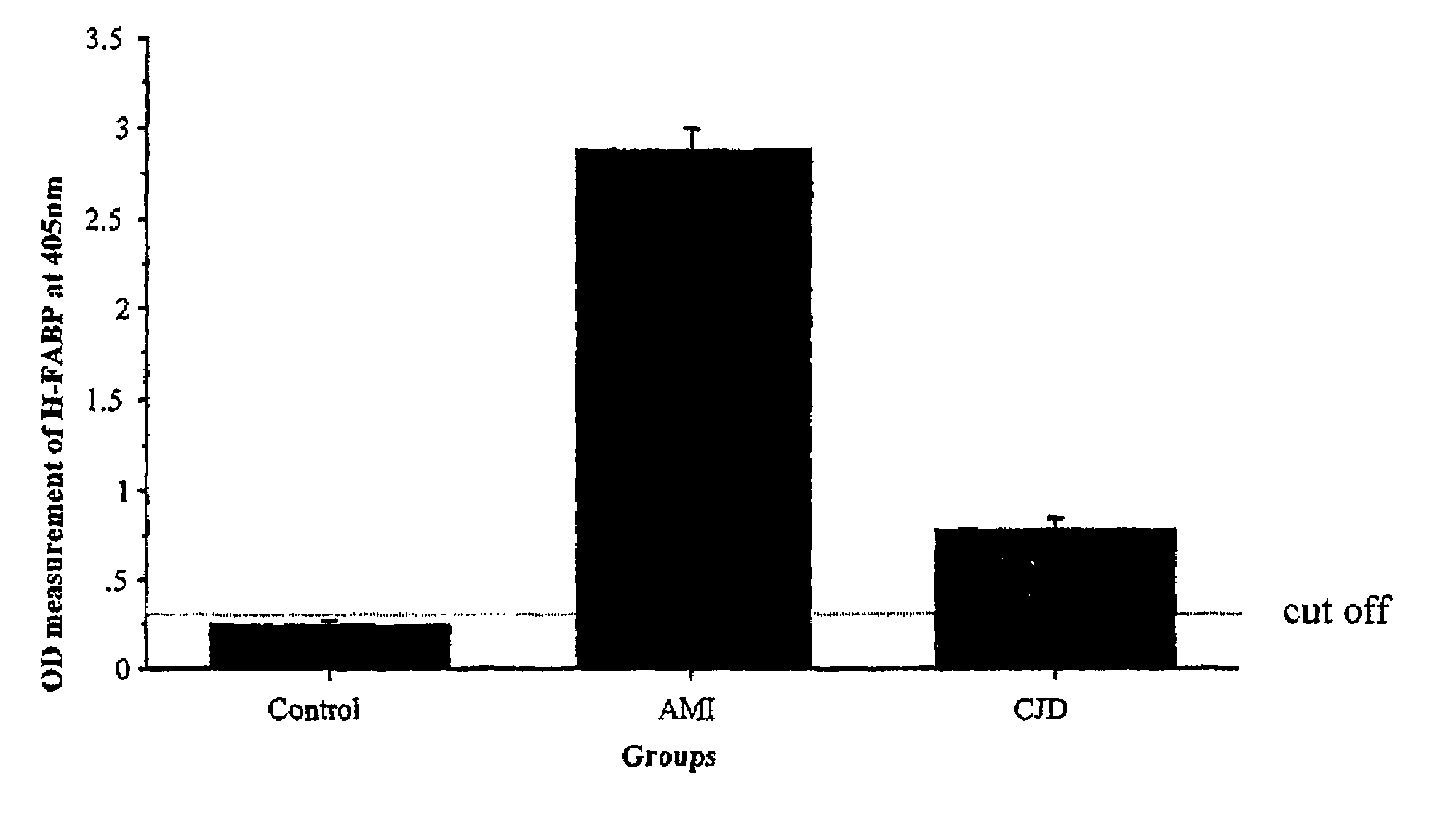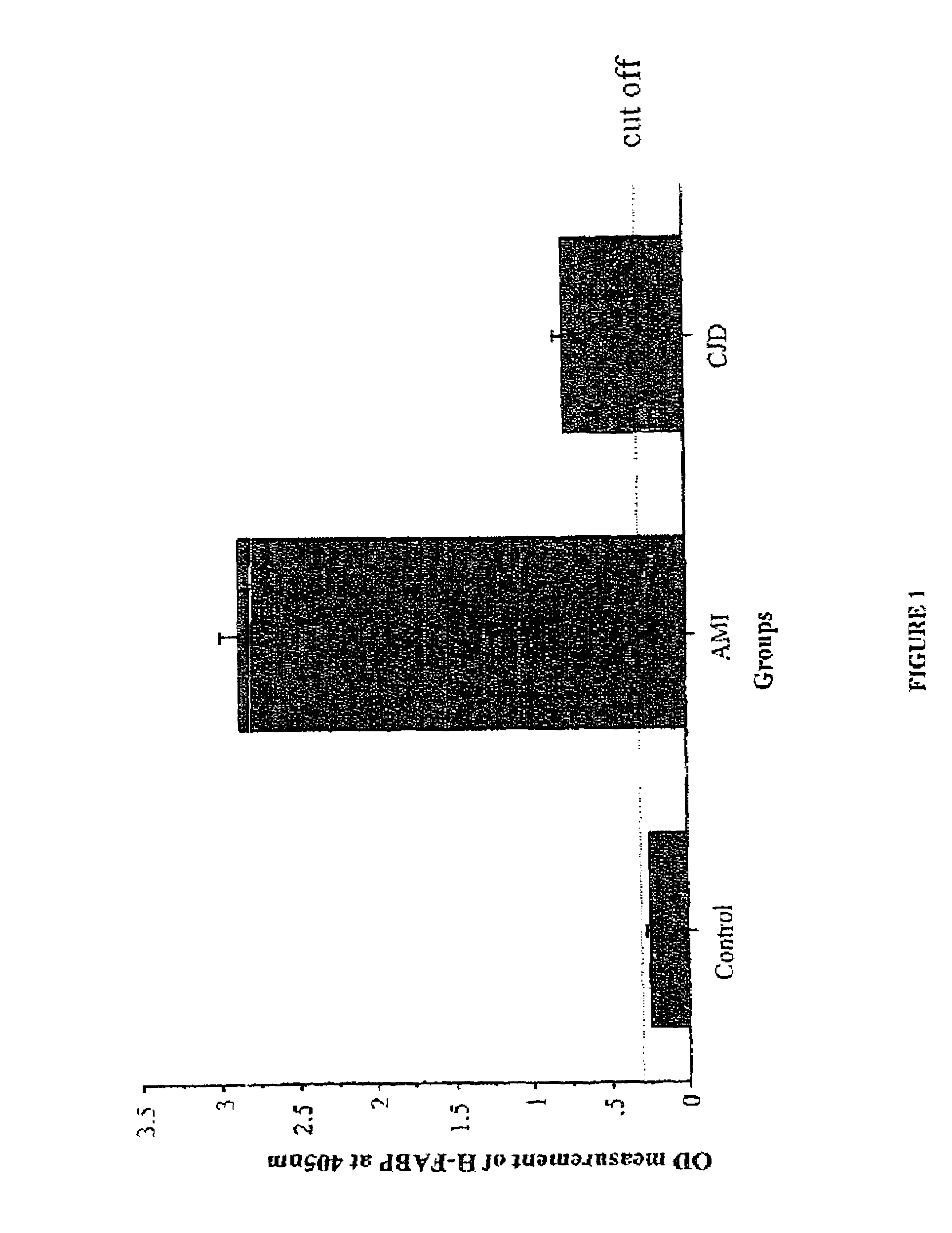Diagnostic assay for transmissible spongiform encephalopathies
a technology of transmissible spongiform encephalopathy and diagnostic assay, which is applied in the field of diagnostic assay, can solve the problems of low specificity, difficult diagnosis of diseases, ataxia, dementia,
- Summary
- Abstract
- Description
- Claims
- Application Information
AI Technical Summary
Benefits of technology
Problems solved by technology
Method used
Image
Examples
example 1
Materials and Methods
Patients
[0031]The study population consisted of 3 age-and-gender matched control patients (Control group), 3 confirmed AMI patients (AMI group), 3 confirmed dementia patients (dementia group) and 3 confirmed CJD patients (CJD group). The Control group included 2 men, mean age 66, range 46-86 years, and 1 woman, age 63 years. The AMI group included 2 men, mean age 65, range 40-90 years, and 1 woman, age 72 years. The dementia group included 2 men, mean age 65, range 43-87 years, and 1 women, age 64 years. The CJD group included 2 men, mean age 68, range 62-74 years, and 1 woman, age 65. Blood and CSF samples were collected for each patient of the CJD. Blood samples were collected in dry heparin-containing tubes. After centrifugation at 1500 g for 15 min at 4° C., tubes were stored at −20° C. until analysis. Patients from the CJD group underwent serial clinical evaluations by neurologists in order to confirm COD diagnosis-Patients from the AMI group were admitted ...
example 2
[0044]Samples of plasma or CSF were taken from human patients. The disease from which the patients were suffering was in some cases clearly CJD, either sporadic (sp) or new variant (v), as determined by autopsy. In other cases (“not CJD ?”), the patient has been diagnosed as not having CJD, but since some of these patients are still alive, this has not necessarily been confirmed by autopsy. The samples were assayed for CJD by the anti-14-3-3 method of the prior art and by the present invention.
[0045]The anti-14-3-3 immunoblot was carried out by running the samples on a 12% SDS-PAGE gel in tris-SDS-glycine buffer. The proteins were thereafter transferred by semi-dry electroblotting at a constant 200 mA for 3 hours, in CAPS buffer, onto a PVDF membrane. The membrane was blocked, incubated with an anti-14-3-3 polyclonal rabbit IgG antibody from Santa Cruz, Inc-(Cat sc 629, Lot L117), washed with buffer and incubated with the second antibody, a goat anti-rabbit immunoglobulin labelled w...
example 3
[0049]The method of the invention was carried out on pooled, concentrated, samples of CSF from 4 cattle diagnosed as having BSE and on pooled, concentrated samples from 3 healthy cattle as controls. (The samples were concentrated with “Microcon”,from Amicon, in order to increase the signal to background ratio).
[0050]A rat / mouse H-FABP ELISA kit from Hycult Biotechnology B.V., Uden, The Netherlands, was used, according to the manufacturer's instructions, the assay being similar in principle to the sandwich ELISA described in Example 1. However, the first antibody, bound to the wells, was anti-rat / mouse H-FABP, rather than anti-human H-FABP, and the second antibody was peroxidase-labelled, anti-rat / mouse. (These antibodies appear to be anti- to both rat and mouse. It should be explained that this kit was not intended to detect bovine H-FABP. It was found unexpectedly in the present invention that the anti-rat / mouse H-FABP antibody recognises bovine H-FABP). The assay is calorimetric, ...
PUM
| Property | Measurement | Unit |
|---|---|---|
| Acidity | aaaaa | aaaaa |
Abstract
Description
Claims
Application Information
 Login to View More
Login to View More - R&D
- Intellectual Property
- Life Sciences
- Materials
- Tech Scout
- Unparalleled Data Quality
- Higher Quality Content
- 60% Fewer Hallucinations
Browse by: Latest US Patents, China's latest patents, Technical Efficacy Thesaurus, Application Domain, Technology Topic, Popular Technical Reports.
© 2025 PatSnap. All rights reserved.Legal|Privacy policy|Modern Slavery Act Transparency Statement|Sitemap|About US| Contact US: help@patsnap.com


